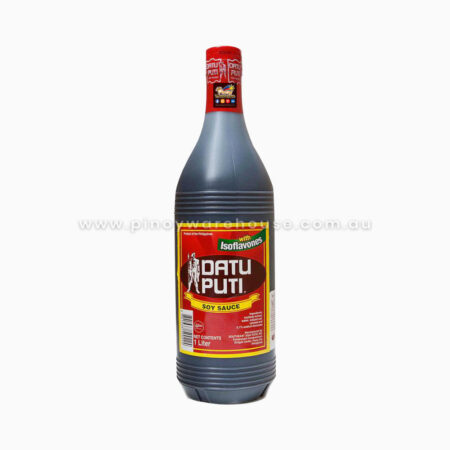
Lesson Hiding in a Bottle of Datu Puti Soy Sauce
You won’t find its ticker symbol on the NYSE, and no analyst will ever issue a buy rating on it. But if you want to understand what makes a business truly durable—what we in the investing world call an economic moat—then I suggest you take a trip to your local Asian grocery store. Head to the condiment aisle, and look for a simple, clear bottle with a red and yellow label: Datu Puti soy sauce.
For two decades, I’ve pored over balance sheets and 10-K filings, trying to quantify the unquantifiable: brand loyalty, pricing power, and cultural staying power. I’ve invested in tech giants that crumbled and ignored boring businesses that became multi-baggers.
And the hardest lesson? The most powerful investment principles often reveal themselves not on a stock chart, but in the everyday products that weave themselves into the fabric of life. That bottle of soy sauce? It’s a masterclass.
Beyond the Balance Sheet: The “Shelf Space” Moats
We love to make investing complicated. We build complex discounted cash flow models and debate the nuances of Fed policy. But sometimes, the most telling metric isn’t on a financial statement; it’s in a store. Walk into any Filipino kitchen, restaurant, or sari-sari store, and you will find Datu Puti soy sauce. Its market dominance isn’t just about sales volume; it’s about mental and physical availability.
This is a concept I first grasped listening to a podcast about consumer staples, not from a Wall Street journal. A company’s moat is deepened every time a product becomes the default choice. When a grandmother teaches her granddaughter to cook adobo, she doesn’t say “add soy sauce.” She says “add Datu Puti.”
That generational transfer of habit is a competitive advantage no startup can easily disrupt. It’s a moat built not with financial engineering, but with tradition and trust. It’s the same reason you might ask for a Coke instead of a cola. The brand is the category.
The Boring Beautiful: Why Simple Products Create Complex Moats
Let’s be honest. Soy sauce is not a sexy business. It’s not an AI-powered app or a quantum computing chip. It’s fermented soybeans and wheat. And that’s precisely where its strength lies. The less a product changes, the harder it is to disrupt.
Think about it. Its utility is timeless. Nobody is going to “Uber” for soy sauce or create a “soy sauce 2.0” that makes the original irrelevant. This creates a stunningly predictable business model. The demand is inelastic; people cook and eat every day, through bull markets and bear markets. This kind of stability is what allows a company to generate consistent cash flow, decade after decade—cash flow that can be reinvested or paid out to shareholders. It’s the ultimate “boring beautiful” business.
The Anchor of a Cuisine: Cultural Embeddedness as an Asset
An economic moat isn’t just a business concept; it’s a cultural one.
A competitor can’t just create a cheaper or slightly better-tasting soy sauce and expect to win. They’d have to disentangle a brand from an entire national cuisine. They’d have to convince millions of people that their family’s traditional recipe is wrong. Good luck with that. This is the investing equivalent of a wide moat with crocodiles. It’s not just a barrier to entry; it’s a barrier that actively defends itself through collective habit.
Price Point vs. Value Point: The Psychology of a Peso
Here’s a question I love to ask investors: What’s the price of a bottle of Datu Puti soy sauce? If you’re like most, you probably have no idea. And that’s the entire point. It’s what I call a low-involvement purchase. The cost is so small relative to a weekly grocery bill that consumers are almost completely price-insensitive.
This gives the brand incredible pricing power. They could likely increase the price by a peso or two, and no one would switch brands or even really notice. The risk of trying an unknown, cheaper alternative far outweighs the minuscule savings.
The perceived risk of ruining a family dinner is too high! This is a powerful lesson for investors: look for companies that sell products where the customer’s decision is based on habit and trust, not on a relentless search for the absolute lowest price. It’s a much more defensible position.
Distribution: The Unseen Army That Guards the Moat
A great product is nothing if it’s not available. The most brilliant strategy I ever heard about for a consumer goods company was simply: “We will be everywhere.” Datu Puti’s distribution network is its unseen army.
It’s in massive supermarkets in Manila and tiny roadside stalls in the most remote provinces. This logistical dominance creates a vicious cycle for competitors: to compete on shelf space, you need sales; to get sales, you need shelf space.
Building this kind of distribution from scratch requires a colossal capital investment and years of relationship-building. It’s a moat that is incredibly expensive and time-consuming to cross. As an investor, when I look at a consumer company, the first thing I try to understand is not just what they sell, but how and where they sell it. An impenetrable distribution network is often a clearer sign of durability than a flashy marketing campaign.
The “Toppling” Risk: Even the Widest Moats Can Be Breached
Now, I’d be a poor coach if I didn’t play devil’s advocate. No moat is forever. History is littered with dominant brands that became complacent. Look at what happened to Sears or Kodak. The biggest risk for a brand like Datu Puti isn’t a direct competitor; it’s a shift in the cultural tide.
What if a health craze suddenly demonizes sodium and MSG? Perhaps they introduce a successfully marketed low-sodium variant or leverage their brand trust to launch new products that align with modern tastes. The lesson here is that defense is not passive. The best companies are always reinforcing their walls, even when they seem unbreachable.
As you analyze a company, ask yourself these questions, inspired by that humble bottle:
- Is this product the default? Is it the “Kleenex” or “Google” of its category?
- Is it boringly essential? Does it solve a simple, recurring need that is immune to technological disruption?
- Is it culturally or habitually embedded? Does it have a tribe of loyal users who would never think of switching?
- Does it have pricing power? Can it raise prices without losing customers?
- Is its distribution a competitive weapon? How hard would it be for a new player to get to where they are?
This framework pushes you beyond the numbers to understand the qualitative why behind a business’s success.
If you’re looking for more ways to connect everyday observations to your financial strategy, the folks over at Great News Live often discuss how global consumer trends can signal bigger shifts, a method I’ve used for years.

Responses